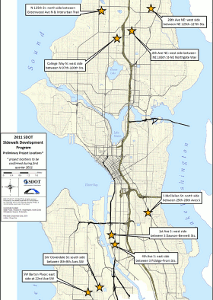The intersection at 1st and University was recently converted to an all-way walk signal, improving pedestrian mobility in the area. However, Dan Bertolet says that’s not good enough:
First and University belongs at the top of Seattle’s list for places where we ought to celebrate urban walkability. The city recently took a positive step in this direction by converting the intersection to a “scramble,” where vehicular traffic is stopped on both streets at the same time, freeing pedestrians to walk in any direction, including diagonally.
With the scramble came the super deluxe new white paint job you see in the photo. When I first saw those truncated diagonal lines I thought they couldn’t possibly be finished, but alas, I have since learned otherwise.
Yes, credit is due to the folks at the city’s transportation department who took the initiative to push the scramble conversion through the bureaucracy. And yes, there are probably arcane city regulations that dictate how intersections can be painted. But c’mon people, is this really the best we can do?
More white lines would be a good start, but what First and University deserves is a full pavement treatment across the entire intersection. Something like the paving on Pine St. between Fourth and Fifth Ave. would be nice, though it wouldn’t have to be that fancy. It just needs to visually distinguish the intersection as place where pedestrians take priority over cars. A raised tabletop would be ideal.
To Dan’s point, the city of Seattle has a special opportunity with this particular intersection. But practically every intersection in the city could be improved further. In this case, at least we have an all-way walk signal, which uses standard striping patterns, even though it may not visually cue drivers to watch out for people walking.
But, with limited funding, is it more important to pay special attention to the intersections that could benefit most from special treatment, or should SDOT focus on addressing the intersections lacking basic infrastructure like sidewalks and curb ramps?
To give credit where it is due, SDOT has done an good job of addressing basic, relatively inexpensive pedestrian needs by striping crosswalks, putting in curb ramps, and adding missing sidewalks.
But, when will they do more than just address basic needs? Will that have to wait for all the basic infrastructure gaps to be fixed?
At some point SDOT is going to have to target more expensive and potentially more controversial improvements like a raised tabletop on 1st and University. And with a pro-pedestrian mayor in place, now seems like a better time than ever.






